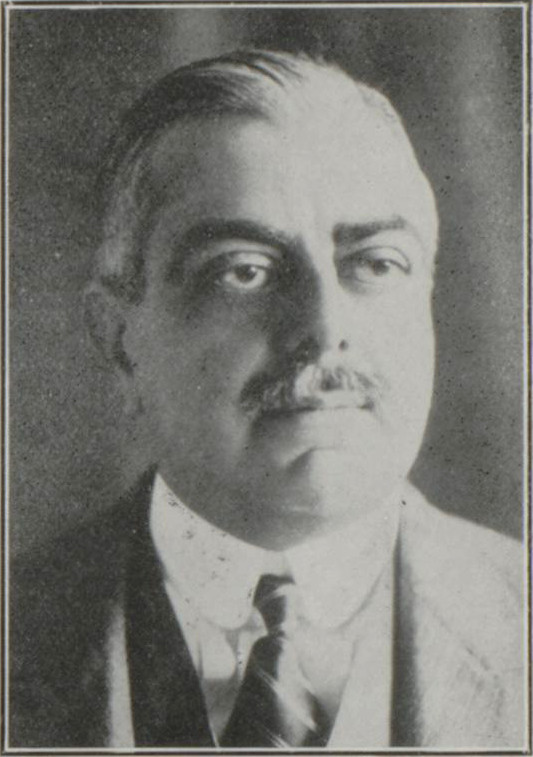| Full name | His Highness Rt Hon. Aga Sultan Sir Mahomed Shah, Aga Khan III, PC 1934, GCSI, 1911, GCMG, 1955, GCIE, 1902 (KCIE, 1898), GCVO, 1923, LLD hon Camb (aka Mohammed Shah; Mohamed Shah) |
| About | As the Aga Khan, a title he inherited upon the death of his father in 1885 aged just seven, Mahomed Shah led the 11-12 milllion-strong Isma'ili sect of the Shi'a Muslim community, and was a powerful voice representing Muslim interests in India and around the world. From 1898 he travelled widely, becoming a fixture of high society in Europe while remaining highly politically active across the Islamic world, particularly in India where he helped found in 1906 (and for a time presided over) the All-India Muslim League. He was decorated by British monarchs stretching from Victoria to Elizabeth II.
The Aga Khan was head of the British Indian delegation at the conference.
For additional biographical information, see the official delegate Who's Whos. See also Emery Kelen's caricature, from his portfolio of delegates at the Round Table Conference.
Pre-Conference
- 31stDecember 1928 - 1st January 1929: at an All Parties Muslim Conference at Delhi, presided over by Aga Khan, also including Shafi from Punjab, Ghaznavi from Bengal, Shafa'at Ahmad Khan UP and Muhammad Ali from UP, a federal system with complete autonomy and residuary powers in the states was suggested, including separate electorates and one third of central seats for Muslims. It amounted to a rejection of the Nehru Report. (Moore, 1974:38)
First Session
- Chairman of the British India Delegation and head of the Muslim delegation
- November 1931: met for almost nightly talks in London at the Nawab of Bhopal's house (25 Upper Brook Street) with Sapru, Sastri and Setalvad, alongside Jinnah and Shafi. (Moore, 1974:126)
- November 12th: At the Opening Ceremony the Aga Khan was chosen to second Patiala’s suggestion the PM Ramsay MacDonald should chair the conference.
- The Aga Khan initially supported federation, along with Jinnah and Shafi with the question of safeguards to be determined later. He was soon deluged by telegrams reminding of this policy which had to be stuck to. (Moore, 1974:144)
- December 5th1930: wrote to Benn confirming stalemate on communal representation (Moore, 1974:159)
- December: much time was spent responding to telegrams demanding that he reserve separate electorates for Muslims (Moore, 1974:159)
- 17thJanuary 1931: the Aga Khan told Lord Reading that without a communal agreement the Muslims would not agree to any scheme for central responsibility of elected Indian representatives (Bridge, 1986:59), and would not participate in future conference proceedings
Second Session
- Chairman of the British India Delegation
- 30th August 1931: Repeated his insistence to Hoare that the minority question must be settled before Federal Structure questions would be debated. He argued against a federal Home Member and that law and order be split between provincial and crown control. (Bridge, 1986:75)
- The Aga Khan joined Sapru in protesting against the move back to the proposals of the Simon Report. These were successful in reversing Sankey and MacDonald’s proposed concluding statement of a two stage process (provincial autonomy and then federation), in favour of one bill (Moore, 1974:237)
Third Session
- Represented Muslims alongside Ghaznavi, Iqbal, Begum Shah Nawaz, Sha'afat Ahmad Khan and Zafrullah Khan.
Post-Conference
- Represented India at World Disarmament Conference, Geneva, 1932
- Made an important contribution to securing a unanimous report from the joint select committee (1933–4) presided over by Lord Linlithgow which resulted in the Government of India Act of 1935. He, however, failed to secure Congress acceptance of a joint memorandum
- 1934 toured Rajputana and the Punjab to promote the federation (Copland, 1997:131)
- Led Indian Delegation to League of Nations Assembly, 1932, 1934, 1935, 1936 and 1937; also to special meetings for Paraguay-Bolivia and Manchurian disputes, and meeting, 1937, when Egypt became member of League of Nations
- President of League of Nations Assembly, Geneva, 1937;
- In 1937, while President of the League Assembly, he visited Hitler, and became a proponent of appeasement.
- Supported British war effort but failed to convince Gandhi to support.
- From 1940 received medical treatment in Switzerland, was not politically active from this point.
|
| Sources | Sources used
- Carl Bridge, Holding India to the Empire: the British Conservative Party and the 1935 constitution (New Delhi: Sterling Publishers; 1986)
- Ian Copland, The Princes of India in the Endgame of Empire, 1917-1947 (Cambridge: Cambridge University Press; 1997)
- R.J. Moore, The Crisis of Indian Unity, 1917-1940 (Oxford: Clarendon Press; 1974)
Selected publications
Videos
Secondary literature
Online resources
|
| Images | 
"H.H.Aga Sultan Sir Mohamed Shah Aga Khan, G.C.S.I., G.C.I.E., G.C.V.O., LL.D." From Indian Round Table Conference Second Session 1931: Biographical Notes and Photographs of the British and Indian Delegates (London: St. James's Palace). By permission of the British Library (shelfmark T 11187). Reproduced under Open Government Licence v3.0 (http://www.nationalarchives.gov.uk/doc/open-government-licence/version/3/) |